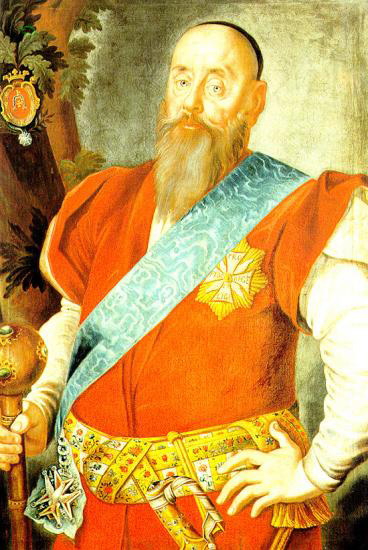 This ornate cloth sash is one of the most distinctive items of Polish, Lithuanian, and Belarusian noblemen’s attire in the 17th-19th centuries. This long, wide, and really luxurious belt showed off the high status of the wearer. But also, a kontush sash was often used as a home décor item – people placed it in the center of the feast table, atop the tablecloth, as a fancy centerpiece. Rarely, articles of clothing are used like this, although many traditional garments and accessories actually look like outstanding decorative items instead of just clothes.
This ornate cloth sash is one of the most distinctive items of Polish, Lithuanian, and Belarusian noblemen’s attire in the 17th-19th centuries. This long, wide, and really luxurious belt showed off the high status of the wearer. But also, a kontush sash was often used as a home décor item – people placed it in the center of the feast table, atop the tablecloth, as a fancy centerpiece. Rarely, articles of clothing are used like this, although many traditional garments and accessories actually look like outstanding decorative items instead of just clothes.
A kontush belt was typically called “pas kontuszowy” in Poland, “kontušo juosta” in Lithuania, “слуцкi пояс” or “Slutsk sash” in Belarus. A kontush is European outerwear, sort of a coat, usually worn belted. That’s why the kontush sash is named like that.
Polish, Lithuanian, and Belarusian noblemen traditionally dressed in a kontush in the 17th-19th century. Their outer garment and ornate belt distinguished them from peasants. The most opulent sashes were crafted using silk and gold.
A kontush belt always was fancy and richly decorated. Its length varied between 3 and 4.5 meters (9.8-14.8 feet) and width was up to 40 cm (16 inches). Depending on the width of the sash, it could be folded in different ways, showcasing various patterns for different occasions. The most elaborate sashes were considered to have four distinct sides.
Origin of kontush sash
The kontush sash, like other components of the Polish national attire, has its roots in the East. Originally, these sashes were imported from Persia and Turkey. However, during the 17th century, several sash factories emerged throughout the Polish-Lithuanian Commonwealth. Among them, the most renowned and prestigious manufactories were located in Slutsk (a city in Belarus). Sashes produced there were highly sought after and commanded the highest prices. Due to their popularity, the Slutsk sashes were sometimes referred to as “pas słucki” (“Slutsk sash”), regardless of their actual place of origin. Slutsk sashes featured two distinct color patterns on each side.

Portrait of the Grand Crown Hetman Wacław Rzewuski, around 1773-1774. He is wearing a beautiful gold-embroidered kontush sash
The famous Polish poet and singer, Jacek Kaczmarski, even dedicated a ballad titled “Z pasa słuckiego pożytek” (“The uses of a Slutsk sash”) to these remarkable sashes. Also, the Slutsk sash has been recognized as a cultural heritage of Belarus.
The kontush sash holds significance as an attribute of nobility. The Polish-Lithuanian Commonwealth had extensive trade connections with Persia and Turkey, which fostered an appreciation for oriental art and decoration across Eastern Europe. The ideology of Sarmathism, which emerged in the 16th century, encompassed various Central European nations. The kontush belt became a visual representation of Sarmathian identity and gained popularity in Lithuania, Belarus, Poland, Ukraine, Hungary, Saxony, Moldavia, Besarabia, and parts of Russia. The nobility, Cossack elders, and high-ranking municipal officials wore kontush belts.
During the prosperous period from the 16th to 18th century, surplus financial resources were often invested in culture, art, and decoration. Polish-Armenian merchants played a role in importing luxurious items such as oriental carpets, gold- and gem-decorated weapons, and expensive fabrics. Kontush belts, in particular, symbolized the bearer's status and were exceptionally costly. As the demand for kontush belts grew, local manufacturing workshops were established within the Polish-Lithuanian Commonwealth. These workshops were primarily opened by Polish-Lithuanian Armenians. While these locally made belts still featured oriental ornamentation, they possessed a distinct character separate from the belts imported from Persia and Turkey.
Practical purposes of kontush belt
The kontush belt also served a practical purpose. When folded in half and wrapped around the body, it functioned as a pocket for carrying money and documents. Most belts were approximately 30 cm wide and around 3.5 meters long. Due to the weaving technique, one side of the belt would be the inverse of the other, allowing for two different color schemes, resulting in a so-called two-sided belt. Further division of the belt created four distinct color compositions, known as a four-sided belt. The price of the belt varied depending on the materials used, with some incorporating silver and gold threads. The intricate designs increased the price further, as they required more sophisticated machinery, highly skilled craftsmen, and a longer production cycle. Four-sided belts were the most expensive and were meant to be worn on different occasions, with each side representing a specific purpose – for example, a bright side for weddings, a dark side for funerals, and a green side for the green kontush or blue side for blue kontush.
Additionally, the belt was often used as a decorative element for tables, placed at the center on top of the tablecloth.


